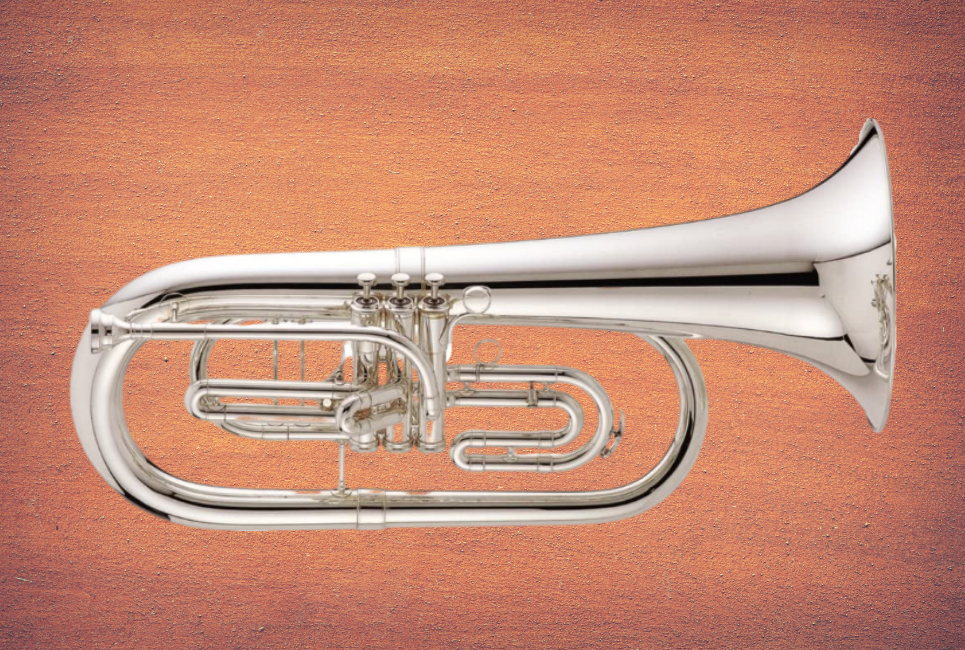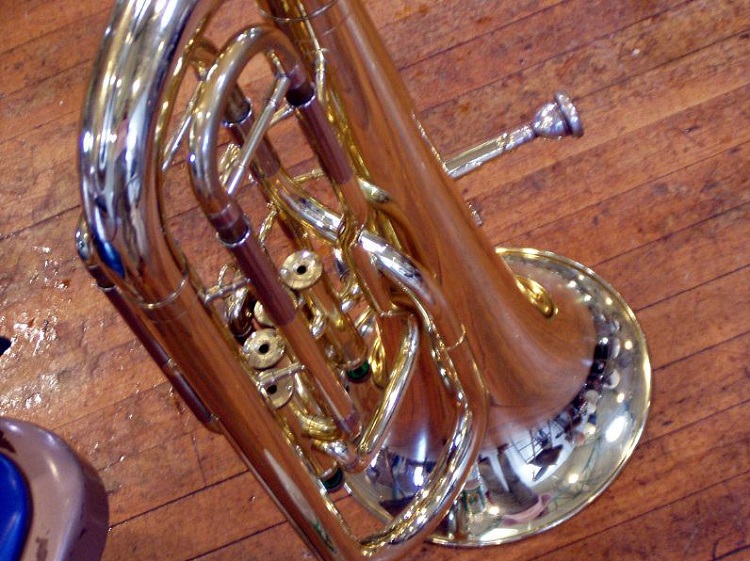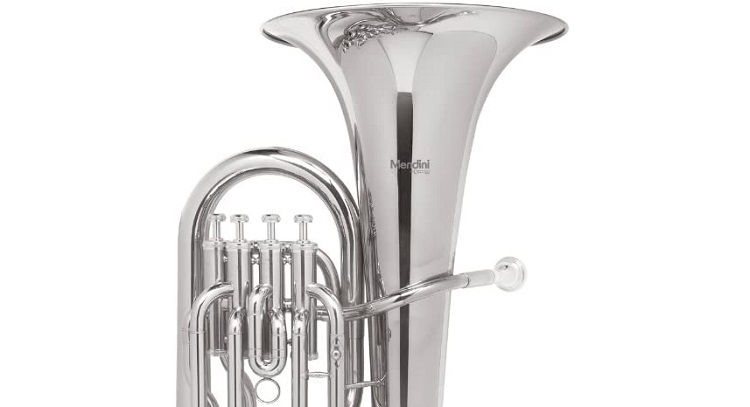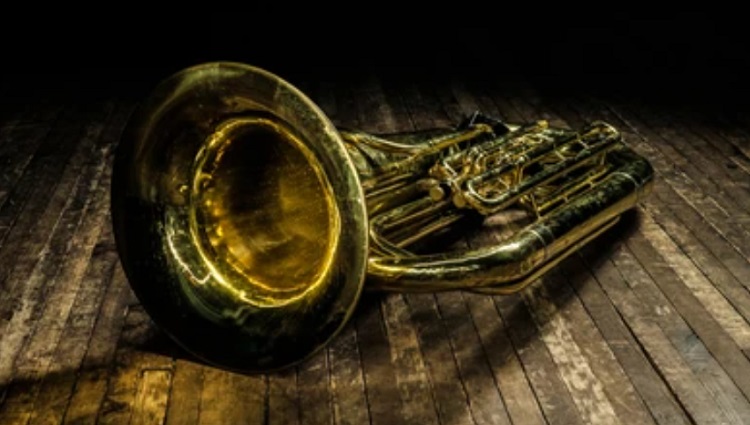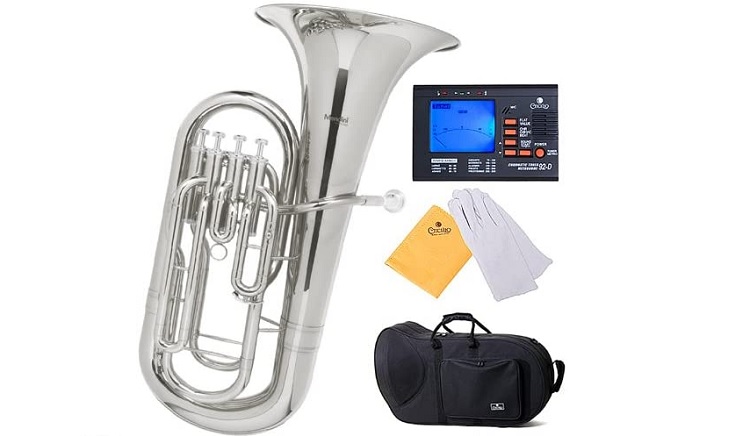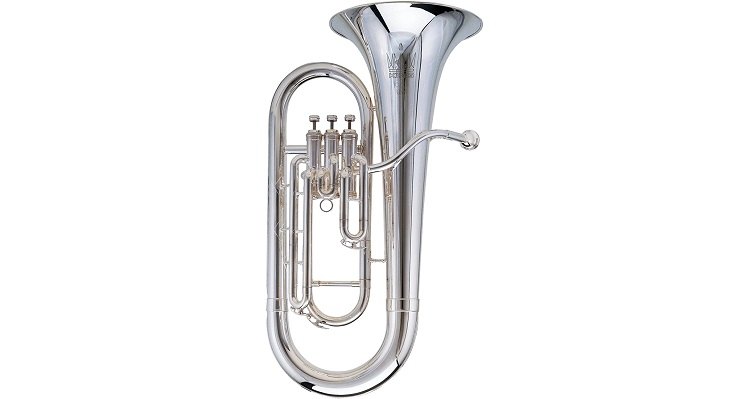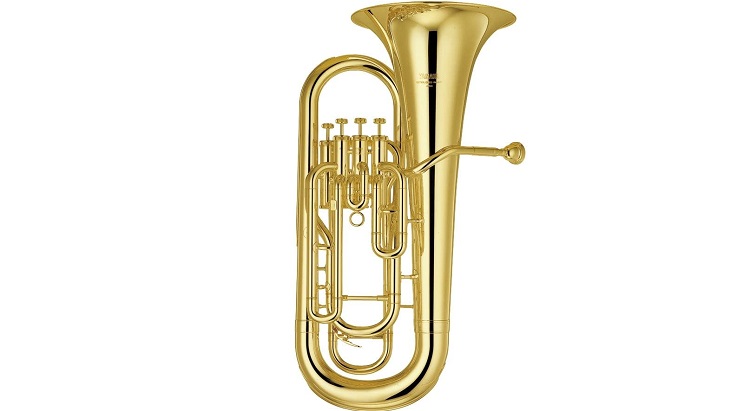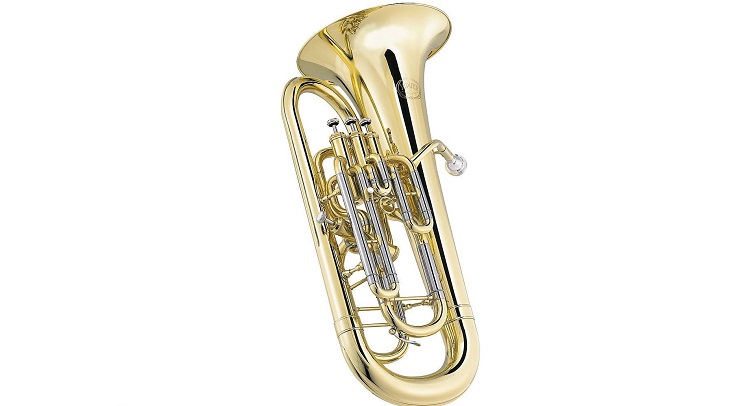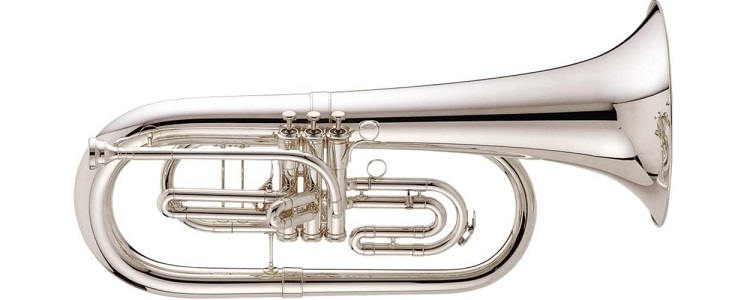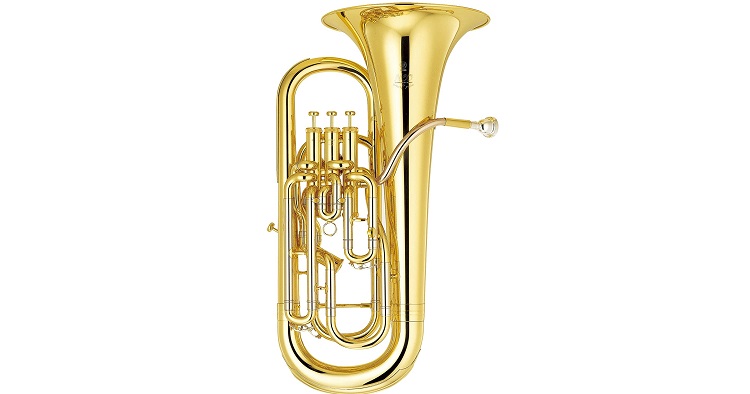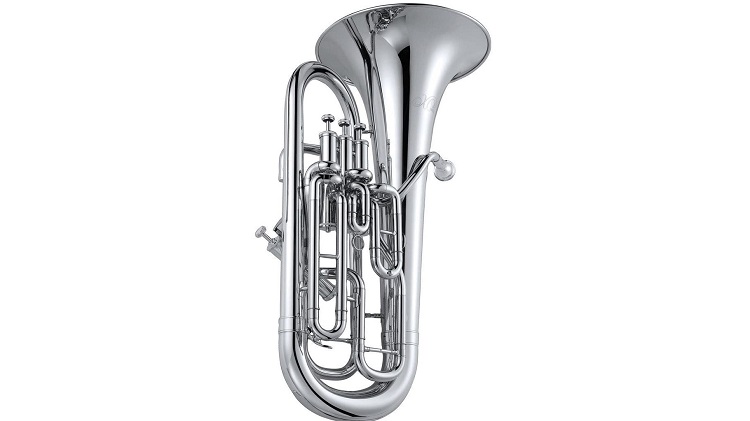- How to Find the Best Sopranino Saxophone - May 31, 2022
- How to Find the Best Contrabass Saxophone - May 30, 2022
- Trumpet Range Guide: Understanding The Entire Trumpet Range - May 19, 2022
Do you want to play a low brass instrument but don’t want to deal with the size of the tuba or the awkwardness of the trombone? Consider how to find the best euphonium.
Then, you can join the low brass in a band or chamber group. You’ll be able to play harmony parts, and you can enjoy the warm tone of the euphonium.
How To Find The Best Euphonium
Whether you’re a beginner or aspiring professional, you need to know how to find the best euphonium. Having the right instrument for you can make a huge difference in the ease of playing and other factors.
If you have to struggle to get a sound, you may want to quit, and that’s understandable. So give yourself as much help as possible by learning how to choose the right model.
Then, you’ll be able to enjoy the time you spend playing the euphonium, and you may just make it a life-long pursuit.
Consider Your Playing
First, you should think about your experience with the euphonium, other brass instruments, and music in general. If you’re new to the euphonium, you may want to start with a beginner model.
However, after you’ve played for a while, that same model may hold you back. You can look at intermediate and professional euphoniums so that you can continue improving as a player.
Different levels have various specs and features that are perfect for that time of your musical journey. Eventually, you may have to search for a new euphonium, even if you don’t want to.
Decide on Specs
Once you decide what type of euphonium you need, start researching the specs available. For example, you can choose between brass lacquer and silver plating as the finish for the instrument.
You can also find euphoniums with either three or four valves, where the fourth valve can make some notes easier. This can be a useful switch when you get to an intermediate or advanced level.
Another spec to think about is if you want a marching euphonium. While they aren’t as common as marching baritones, they do exist, and the instrument can be a good investment if you like to play in a marching band.
Set a Budget
The next step in how to find the best euphonium is to determine how much you can and want to spend. Some euphoniums can cost thousands of dollars, but you don’t have to spend that much.
Instead, you need to be realistic about getting a good instrument. Go back over your level of playing and the specs you want to get with your new euphonium.
Then, you can research available models that meet those needs, and check out how much they cost. Use that information to set a budget that will give you plenty of instruments to test and compare.
Find a Mouthpiece
Some euphoniums come with a suitable mouthpiece, but you may want to buy one separately. That way, you can choose a mouthpiece that has the shape and specs you want.
For example, a mouthpiece with a bigger cup can offer a bigger sound, while a smaller cup can help you play high notes. If you like to play a specific part or style, you may want to buy a mouthpiece that can help with that.
When you have a mouthpiece you like, you can find a body that matches it. Then, you don’t have to limit your search based on instruments that come with the right mouthpiece style for you.
Select Test Music
Now, you’re almost ready to start trying euphoniums, but you should consider how you’ll test them. Instead of just playing whatever pops into your head, come up with a list of pieces or exercises.
You can make sure the music you select covers the entire range of pitches, dynamics, and tempos. That way, you’ll be able to get to know the instrument and determine if it’s the right fit.
Choosing your test music ahead of time also lets you minimize the differences between euphoniums. When you play the same stuff, you can listen to each euphonium and know differences come from the instruments rather than the music.
Look for Reputable Brands
You can find tons of euphonium brands online and in music stores. However, some of those brands aren’t as good as others, and they may impede your progress as a musician.
If possible, stick to the more reputable brands, such as Yamaha and Jupiter. That way, you can get the best quality instrument within your budget.
Now, that doesn’t mean you have to write off cheaper brands. But you may need to lower your expectations a bit so that you can get an instrument you like, and you don’t have to spend as much to start playing.
Get a Euphonium
Now, you’re finally ready to get your hands on a euphonium, and you can do this in a couple of ways. First, you can head to a local music store to try a few instruments in person.
Another great option is to order a trial through an online retailer, so you’ll be able to test a few euphoniums at home, and you can ship the instruments back after you choose one to keep.
While not ideal, you may also want to look for a retailer with a generous return policy. If you can’t schedule a trial, you can order one euphonium at a time to try, and you can return it if you don’t like the model.
Record Your Test
When you get a euphonium and test it, record yourself with your smartphone or a recording device. This is particularly useful if you can’t try multiple euphoniums back to back.
You can use the recordings to remind yourself of how each model sounds after you can try a few. When you listen back, you might also notice certain nuances you missed during your trial.
Plus, recordings are perfect to use to get someone’s opinion on the various euphoniums. If you have a teacher, send them the trial recordings to get their feedback to help decide which euphonium you should get.
Eliminate Models
As you test euphoniums, you may find that some are much better for you than others. Whenever you come across something you don’t like, take that euphonium out of the running.
It doesn’t matter if that thing is small, such as how the valves feel. If you don’t absolutely love the euphonium, you may end up regretting the purchase.
So don’t be afraid to set an instrument aside and try another one. You can even order a different instrument of the same model. At the professional level, you can find small differences that are enough to change how the model feels and sounds.
Try a Used Euphonium
A new euphonium can be a great option, but don’t count out used models until you try a few. In a lot of cases, used models cost less than new ones, but they can be just as good.
As long as the prior owner took good care of the euphonium, it may be in like-new condition. But used instruments usually sell for less, so you can get a good deal.
You might also be able to find different models available on the used market. Some older euphoniums sound great, and you can get a unique instrument.
Borrow a Euphonium
If you can’t seem to find a euphonium that you can afford, find a way to borrow one. For example, you can ask a college or community band if they have instruments to loan out to you.
You may also want to ask a teacher or another euphonium player that you know. They can loan you a backup instrument while you save up to purchase your own.
Borrowing a euphonium is a great way to test one out over more than a few days. Over that time, you may decide that you want to get the same model, or you may choose to look at a different one.
Keep Looking
As frustrating as it may be, you won’t always find the best euphonium on your first try. You may need to order and return a few instruments or do a few trial sessions to discover one you like.
However, doing this will save you a lot of time and money down the line. When you finally find the right euphonium for you, it will be even more rewarding.
And you can make sure that you won’t end up with buyer’s remorse. Instead, you’ll look forward to playing your instrument each day.
Best Euphoniums
Even when you know how to find the best euphonium, you may still struggle to do so. If you don’t know what models are worth it, you may waste a lot of time trying duds.
To help choose the best euphoniums, I looked at the price, quality, and ease of playing.
Fortunately, there are a few fantastic models and brands at all price points and levels. So when setting up a trial or ordering a euphonium, be sure to add some of the following to your list.
Mendini MEP-L
The Mendini MEP-L euphonium is a fantastic option for players on a tight budget. While it may not last as long as some others, it’s a fraction of the price.
If you can’t borrow or rent a euphonium but want to try one out, get the Mendini. There’s a lacquered brass body with a rose brass leadpipe, so you can get a warm sound.
It even features a fourth valve, which can make playing certain notes easier. You also get a silver-plated mouthpiece, so you can start playing the instrument as soon as you get it.
Pros
- Affordable
- Great for students
- Good features and sound
Cons
- Not for professionals
King Model 628
Another great euphonium to consider is the King Model 628. This instrument is silver-plated, which can offer a bit of brilliance to your sound.
It features three valves, which is pretty standard among student-level euphoniums. Even though that can limit some of the fingerings, it means you don’t have to learn as many fingerings as a beginner.
King makes some fantastic brass instruments. If you’ve played a King trumpet, for example, you may find the King Model 628 is the right euphonium for you.
Pros
- Great for students
- Brilliant sound
- Easy to play
Cons
- A bit expensive
Yamaha YEP-321
The Yamaha YEP-321 is another excellent euphonium for students and intermediate players. Its bore offers a great sound and easy response, so you can play the entire range of the instrument.
There’s a small shank receiver, so keep that in mind when selecting a mouthpiece. That way, you can get one that works with the instrument.
You can experiment with different fingerings due to the four valves, and the brass lacquer looks and sounds good. However, you may need to save up some money before you buy it.
Pros
- Great response and sound
- Suitable for intermediate players
- Small shank receiver
Cons
- Not the most affordable
Jupiter 570L
The Jupiter 570L is an amazing instrument for beginners and other players. It features three valves plus a fourth that you trigger with your left hand.
You get a yellow brass body that looks and sounds great, so you can produce a rich sound. The model works well for solo and ensemble playing, so you don’t need a second instrument.
Jupiter’s design of this euphonium makes it comfortable to hold and play. It comes with a case and accessories, so you have everything you need to get started.
Pros
- Good sound
- Great for beginners
- Comes with what you need
Cons
- Fourth valve can be awkward
King 1129
Marching euphoniums aren’t that common as most players use a marching baritone. However, the King 1129 is worth considering if you need a good horn for the marching field.
It features a silver-plated body and nickel-plated valves. To help with tuning, you can use and adjust the first and third valves with valve slides.
Unfortunately, you don’t get a fourth valve on this model. But you do get a protective case and a good quality mouthpiece, so you can start practicing as soon as you receive the instrument.
Pros
- Marching design
- Good sound
- Easy to hold
Cons
- No fourth valve
Yamaha YEP-642II
An amazing professional model to consider is the Yamaha YEP-642II. This euphonium is great for advanced students and professional musicians who need the best possible gear.
Like the Jupiter J570L, this model features three valves on top and one on the side. That way, you don’t have to strengthen your pinky to use all of the valves.
You also get a professional mouthpiece that fits in the small shank receiver. And everything comes in a case to help protect your investment when you aren’t playing.
Pros
- Suitable for professionals
- Great features
- Sounds good
Cons
- Not for beginners
Jupiter 1270S
The Jupiter 1270S euphonium is another professional model, and this one features silver plating. It has the same valve setup as the other Jupiter model, so it can be easy to upgrade to this one.
This model has a massive bell, which can help you project your sound over an ensemble. And the rose brass mouthpiece helps you get a warm tone out of the instrument.
Unfortunately, it is pretty expensive, so be sure that you can return it if you don’t like it. But it’s worth trying in case you do enjoy how it sounds and feels to play.
Pros
- Great for pros
- Good sound
- Suitable upgrade
Cons
- Pretty expensive
FAQs About How To Find The Best Euphonium
Answer: The euphonium has a larger bore compared to the baritone horn, meaning there’s more space for air to vibrate. A euphonium also has a conical tube, meaning that it slowly gets bigger from the mouthpiece to the bell.
However, a baritone horn features a cylindrical bore, so the diameter stays the same until the bell. Baritone horns also feature tighter wrapping of the tubing. Four valves are also less common on baritones than euphoniums.
Answer: There are many great reasons to play the euphonium, including the warm sound. However, it’s not as big as the tuba, so it can be an excellent alternative for smaller players.
You can also play a harmonic role in a wind ensemble, and you don’t have to worry about a ton of competition. So if you want to have more performance opportunities, the euphonium may be perfect for you.
Answer: The right time to play the euphonium is less about your age and more about your size. You should be able to hold the instrument and not feel like it’s weighing you down.
If you want to give the euphonium a try, find one that you can test out. Then, you’ll be able to make sure it’s not too big for you to handle.
Answer: Euphoniums are expensive because they’re big instruments. The makers need to find and use more materials to make a euphonium than a smaller instrument, like a trumpet.
Because of that, it can also take a lot of time to make a euphonium. An instrument’s price will also reflect the labor and time costs, so handmade instruments will cost more than machine-made models.
Answer: The amount you should spend on a euphonium depends on many factors. Of course, you don’t want to use all of your savings to get an instrument, especially as a beginner.
So think about your playing level and if you need any advanced specs. If not, you can spend a little bit less and get an instrument that meets your needs. After you’ve played for a while, you may want to spend more on an upgrade.
Answer: If you decide to get a really cheap euphonium, consider spending a bit more money on a better mouthpiece. That’s the part of the instrument that touches your lips.
A good mouthpiece will be comfortable, and it will have the right shape based on the sound you want. So if you struggle to get a good sound, you may be able to pay for a mouthpiece instead of a whole new instrument.
Answer: You can teach yourself the euphonium, but you’ll need to have discipline and motivation to practice. If possible, try to take at least one or two lessons with a teacher to learn the basics and avoid developing bad playing habits.
At the very least, you should get a good euphonium method book. Use the book to determine what concepts to learn next so that you don’t miss any essential concepts.
Answer: The euphonium can use either the bass or the treble clef. When reading music in the bass clef, the music will be in concert pitch, so the note you see is the note you hear.
For some reason, and I don’t know why, the euphonium will sound a whole step lower than the notes written in the treble clef. But the fact that you can read music in both clefs means you can switch to the euphonium from most instruments.
Final Note On How to Find the Best Euphonium
Knowing how to find the best euphonium is crucial if you want to play the brass instrument. Be sure to shop around to find different models in your budget.
You should try models from Jupiter, Yamaha, and other brands. That way, you’ll be able to find a model that meets your needs and that can serve you well as you learn music.
Looking for more interesting readings? Check out:

